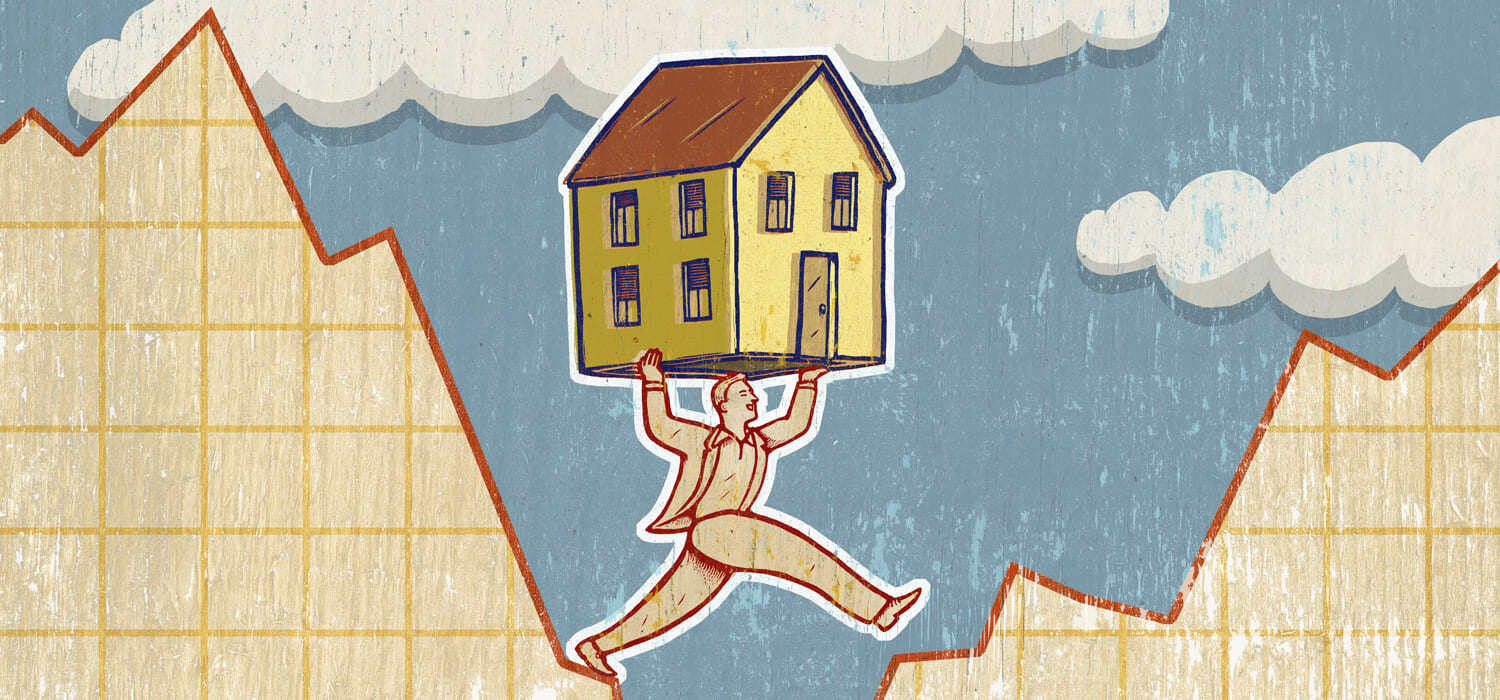
KEY POINTS
- CoreLogic figures show just under 95% of existing homes on the market in the first quarter of the year were resold at a profit
- The company says the median profit made on a resale was $265,000
- PropTrack has released its home price forecasts for the next financial year, pointing to gains in every capital city, with Perth and Adelaide leading the way
This week’s hotter-than-expected inflation data and its implications for interest rates remaining higher for longer have come as a major blow to homeowners struggling with a mortgage.
However, two reports from rival data analytics firms—CoreLogic and PropTrack—point to the underlying strength of Australian property and the very real capital gains people who already have a foothold in the property market have made and stand to make over the next year.
This has the potential to put many stretched mortgage holders into a stronger position when they look to refinance loans, as it shows that the overwhelming majority will have built up more equity in the properties they own than when they took out a loan.
CoreLogic’s latest “Pain and Gain” report:
Each quarter, CoreLogic sifts through Australian property transactions to see whether owners have made a profit or a loss.
CoreLogic’s Australian Head of Research, Eliza Owen, has just finished analysing around 85,000 property resales that occurred between January and the end of March this year and she’s found 94.3% of transactions recorded a nominal gain.
In other words, just under nineteen in twenty owners made a profit when they sold a property in Australia.
It’s the highest level of profitability recorded in 14 years and all the more remarkable when you consider that it came at a time of the highest interest rates in more than a decade, a cost-of-living crisis and a per-capita recession in Australia.
As CoreLogic’s “Pain and Gain” report puts it, the profitability has come about “thanks to consistently rising home values outweighing economic challenges and persistently high mortgage rates.”
If you put a dollar figure on those gains, CoreLogic calculates that the median nominal gain by someone who sold a property was $265,000, while the total nominal resale profit across Australia was $28.6 billion.
For the small cohort who didn’t make a profit when they sold their property, CoreLogic says the median nominal loss was $40,000, and the total nominal resale loss was $278 million.
“Despite the slight drop off in the median nominal gain, the rate of sellers making a profit has improved over the year and is the highest in Australian dwelling sales since July 2010,” Eliza Owen says.
“This increase in the profitability rate across the Australian housing market helps to shore up financial stability for many property owners at a time when higher mortgage costs are starting to take their toll on household budgets.”
Adelaide and Brisbane tied as the most profitable cities, with a loss-making rate of just 1.6% of resales, while 6.4% of sellers in Perth recorded losses when they sold.
That’s a remarkable turnaround in just a few years, considering 43.8% of Perth sellers faced a loss when they sold property in the June quarter of 2020.
As for types of property?
Houses (97.1%) continued to deliver higher rates of profit-making sales compared to units (89%).
While Eliza Owen says the gap between house and unit profits has roughly tripled in the past four years, she doesn’t see that trend continuing.
“Affordability and supply constraints are kicking in, and as a result, units are becoming increasingly attractive to those who have been priced out of certain markets.”
“Slowly, that gap between the price of detached housing and medium to high-density options should decrease, and with that, profitability of units will improve,” she says.
PropTrack’s latest price growth forecasts:
While CoreLogic has been examining past sales data, rival firm PropTrack has been trying to forecast the direction the property will take over the next 6-12 months.
PropTrack’s latest Property Market Outlook Report forecasts that Australian home prices will increase by as much as 5% in 2024, pointing out that by their calculations, national prices have already risen 2.7% from January to May.
The firm says, prices nationally are up 5.9% over the financial year to date (July 2023 to May 2024) and are expected to rise a further 2% to 5% in the 2024-25 financial year.
Again, Perth is projected to lead home price growth, albeit at a slower pace.
PropTrack calculates Perth home prices have risen 18.9% between July 2023 and May 2024.
During the 2024-25 financial year, they’re predicted to increase a further 8% to 11%.
And despite varying rates of home price growth in Brisbane (+12.2%), Sydney (+5.8%) and Melbourne (+0.8) between July 2023 and May this year, each city is projected to see home prices rise between 3% and 6% in FY25.
Adelaide prices are expected to grow by a more moderate 5% to 8% in FY25, following a large 12.9% jump between July last year and May 2024.
PropTrack’s Director of Economic Research, Cameron Kusher, says the property market “is proving to be far more resilient than anticipated.”
“Buyer demand remains strong despite interest rates sitting at 12-year highs, borrowing capacities falling and the volume of stock for sale increasing, leading property prices to rise at a faster rate than expected.”
“Over the next financial year, the introduction of Stage 3 tax cuts and projected interest rate cuts have the power to further entice buyer demand, while supply from new dwelling commencements and completions are expected to remain low.”
Stay Up to Date
with the Latest Australian Property News, Insights & Education.




.png?width=292&height=292&name=Copy%20Link%20(1).png)
 SIGN UP FOR FREE NEWSLETTER
SIGN UP FOR FREE NEWSLETTER


.png)




.jpg?width=1920&height=1080&name=Warning%2c%20You%20Might%20Be%20Facing%20Higher%20Taxes%20Soon%20(1).jpg)





.png?width=1920&height=1080&name=Rate%20Drops%20Signal%20BIGGEST%20Property%20Boom%20in%20DECADES%20(1).png)

.jpg?width=1920&height=1080&name=Labor%20vs%20Liberal%20These%20Housing%20Policies%20Could%20Change%20the%20Property%20Market%20Forever%20(1).jpg)
.jpg?width=1920&height=1080&name=QLD%20Slashes%20Stamp%20Duty%20Big%20News%20for%20Investors%20%26%20Home%20Buyers%20(1).jpg)
.jpg?width=1920&height=1080&name=Trump%20Just%20Slapped%20Tariffs%20%E2%80%93%20Here%E2%80%99s%20What%20It%20Means%20for%20Australia%20(1).jpg)
.jpg?width=1920&height=1080&name=Federal%20Budget%202025%20More%20Debt%2c%20No%20Housing%20%E2%80%93%20Here%E2%80%99s%20What%20You%20Need%20to%20Know%20(1).jpg)
.jpg?width=1920&height=1080&name=Australias%20Housing%20Crisis%20is%20about%20to%20get%20MUCH%20Worse%20(New%20Data%20Warns).jpg)
%20(1).jpg?width=1920&height=1080&name=Australias%20RENTAL%20CRISIS%20Hits%20ROCK%20BOTTOM!%20(2025%20Update)%20(1).jpg)
%20(1).png?width=1920&height=1080&name=Is%20Adelaide%20Still%20a%20Good%20Property%20Investment%20(2025%20UPDATE)%20(1).png)
.jpg?width=1920&height=1080&name=RBA%20Shocks%20with%20Rate%20Cuts!%20What%E2%80%99s%20Next%20for%20Property%20Investors%20(1).jpg)
%20(1).jpg?width=1920&height=1080&name=I%20Predict%20The%20Feb%20Rate%20Cut%20(My%20Price%20Growth%20Prediction)%20(1).jpg)
.png?width=1920&height=1080&name=Why%20Property%20Prices%20Will%20Rise%20in%202025%20Market%20Predictions%20(1).png)
.jpg?width=1920&height=1080&name=Why%20Investors%20Are%20Choosing%20Apartments%20Over%20Houses%202%20(1).jpg)
.jpg?width=1920&height=1080&name=Why%20Rate%20Cuts%20Will%20Trigger%20A%20Property%20Boom%20(1).jpg)
.jpg?width=1920&height=1080&name=Retire%20On%202Million%20With%20One%20Property%20(Using%20SMSF).jpg)
.jpg?width=1920&height=1080&name=4%20Reasons%20Why%20You%20Should%20Invest%20in%20Melbourne%20Now%20(1).jpg)
%20(1).jpg?width=1920&height=1080&name=Old%20Property%20vs%20New%20Property%20(Facts%20and%20Figures%20Revealed)%20(1).jpg)
%20(1).jpg?width=1920&height=1080&name=Will%20The%20New%20QLD%20Govt%20Create%20a%20Property%20Boom%20or%20Bust%20(My%20Prediction)%20(1).jpg)
%20Scott%20Kuru%20(1).jpg?width=1920&height=1080&name=Inflation%20Hits%20Three-Year%20Low%20(Will%20RBA%20Cut%20Rates%20Soon)%20Scott%20Kuru%20(1).jpg)
.jpg?width=1920&height=1080&name=How%20to%20Buy%20Investment%20Property%20Through%20SMSF_%20The%20Ultimate%20Guide%20(1).jpg)
.jpg?width=1920&height=1080&name=Victoria%20Slashes%20Stamp%20Duty%20Melbourne%20Set%20to%20Boom%20Scott%20Kuru%20(1).jpg)
.png?width=1571&height=861&name=Are%20Foreign%20Buyers%20Really%20Driving%20Up%20Australian%20Property%20Prices%20(1).png)
.jpg?width=1920&height=1080&name=The%20Single%20Factor%20That%20Predicts%20Property%20Growth%20Regions%20(1).jpg)
%20Scott%20Kuru%20(1).jpg?width=1920&height=1080&name=My%20Prediction%20On%20Rates%20%26%20Negative%20Gearing%20(Market%20Crash)%20Scott%20Kuru%20(1).jpg)

-1.png?width=1920&height=1080&name=Major%20Banks%20Cut%20Rates%20Will%20RBA%20Follow%20Suit%20(Sept%20Rate%20Update)-1.png)
%20Scott%20Kuru-1.png?width=1920&height=1080&name=Rate%20Cut%20Coming%20What%20New%20Zealands%20Move%20Means%20for%20Australia%20(Sept%20Prediction)%20Scott%20Kuru-1.png)
%20(1).jpg?width=1920&height=1080&name=Buy%20when%20the%20interest%20rates%20are%20high!%20(Why%20you%20must%20buy%20now!)%20(1).jpg)
.jpg?width=1920&height=1080&name=Carms_Revised%20Taxes%20Due%20Aug%209%20YT%20Thumbnail02%20(1).jpg)
.jpg?width=1920&height=1080&name=Carms_Too%20Little%20Too%20Late%20Aug%207%20YT%20Thumbnail01%20(1).jpg)









.jpg?width=1920&height=1080&name=Carms_Rate%20Drop%20In%20July%20Jun%2010%20YT%20Thumbnail02%20(1).jpg)
.jpg?width=1920&height=1080&name=Carms_Own%20a%20Property%20V6%20Jun%205_YT%20Thumbnail%20(1).jpg)









.png?width=1920&height=1080&name=Artboard%201%20(3).png)






.jpg?width=1920&height=1080&name=YT%20thumbnail%20%20(1).jpg)

